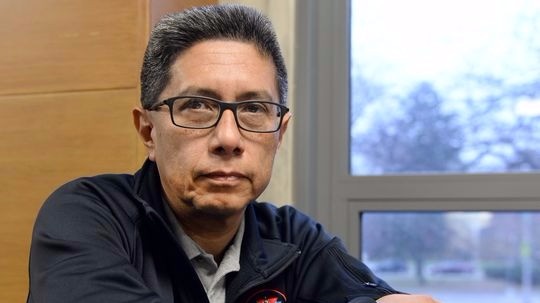Her earliest memories involve a trek through a desert.
Viviana Alamillo was 3 years old and dehydrated — sick with what her family would later learn was lead poisoning — when she was carried through a desert landscape, then trucked across the U.S. border into Texas.
But those memories are scant.
Most of Alamillo’s memories are anchored in the U.S.; not in her illegal crossing from Veracruz, Mexico.
“This has been our land for so long,” the 22-year-old Lansing woman said. “I don’t remember what it is to be a Mexican in Mexico.”
Alamillo is a first-generation college student, a competitive runner, a former intern at both the state and U.S. House of Representatives.
But her legal rights to live, work and study in the U.S. remain tenuous.
For years, she was among the estimated 1,600 undocumented immigrants in the Lansing area, according to the Center for Migration Studies of New York; one of the estimated 130,000 living in Michigan, according to the Pew Research Center.
They live a life without identification, without the papers that could improve their future prospects in education or vocation.
Even as the number of undocumented people removed from Michigan plummets, fear of deportation persists. Many who are brought to immigration court face years of delays and little assurance about their future in the U.S.
And though the nation's heated immigration debate caught fire during the presidential campaign, there has been little done to address the uncertain futures of the undocumented community.

A life without papers
Alamillo is among the thousands of people seeking a life in Michigan without proper documentation.
While some of those sojourners illegally crossed borders, many others came into the U.S. legally and overstayed visas they obtained for work, study or tourism.
Of the estimated 130,000 undocumented people in Michigan in 2014, experts believe about 35% are from Mexico, 13% from India and 6% from China.
Many work at construction sites, clean houses, cook or wash dishes at restaurants, plant and harvest fields or work on dairy farms.
“I am sure every single day of your life you see an undocumented person,” said Oscar Castaneda, director of operations for Action for Greater Lansing and chair of the agency's Civil Rights for Immigrants task force. “The thing is, you don’t know they’re an undocumented person.”
Among the papers that undocumented immigrants lack, one of the most problematic is a driver's license, Castaneda said.
Without a driver’s license, immigrants have trouble getting to and from jobs. They're unable to get insurance or open a bank account, they can't take their kids on school field trips, and they face sanctions if discovered by authorities.
Mario and Ana are among the thousands of undocumented people who have driven without a license — a source of constant concern for the Mexican natives who immigrated to the U.S. 15 years ago.
Mario was 23 and “looking for a better life” when he left Michoacan, Mexico, trekked across the Arizona desert and boarded a bus for Lansing.
In the years he’s lived in the state’s capital city, he’s maintained a steady job, met his wife, and raised three daughters, one of whom is now working on her master’s degree in clinical social work.
Because Mario does not yet have legal status, the Lansing State Journal is not using his last name.
Mario’s wife, Ana, entered the U.S. the same year as her husband, in 2001, on a tourist visa. The former school teacher met Mario in Lansing and decided to stay. Her visa expired years later.
When his daughters were still young, Mario was arrested in 2004 by an immigration official while on vacation in northern Michigan and — at the threat of deportation proceedings — agreed to voluntary removal.
He crossed from Mexico into the U.S. again a month later. This time he waded across the Rio Grande to get back to his daughters.
Though he acknowledges his actions were illegal, he and his wife ask people to put themselves in the shoes that crossed that border in 2001 and 2005.
“We are not killers,” Mario told the State Journal. “We are not drug dealers. We are hard-working people that come here to give our kids a better life.”
Ana obtained legal status in 2015. Mario also has applied for his green card, though his case is less certain given his two illegal crossings.
The couple admitted that had they known what life would be like in the United States, they might not have made the same decisions they did 15 years ago. And if an immigration judge eventually denies Mario’s petition to stay in the U.S., he and Ana are prepared to honor that order.
“We’ve got to take that decision,” he said.
Fewer undocumented immigrants removed
According to Immigration and Customs Enforcement, the agency removed about 2,431 people from Michigan and Ohio in fiscal year 2015. The two states comprise ICE’s Detroit Area of Responsibility, said Khaalid Walls, a spokesman for the agency.
In fiscal year 2010, the agency removed 8,054 undocumented immigrants from the two states.
Walls said the large decrease in deportations is a result of more targeted enforcement, in which ICE officials prioritize cases involving a felony conviction or a threat to national or border security.
For example, he said, ICE agents took into custody a 20-year-old Brazilian national in October 2015 who’d been arrested by Meridian Township police. The immigrant has a felony conviction for third-degree criminal sexual conduct. A 40-year-old Guatemalan national convicted of embezzlement was arrested by ICE in Lansing in February.
Both undocumented immigrants are detained while they await removal. Walls would not release their names.
But activists believe more than new priorities are contributing to the drop in deportations.
"With Mexico’s economy improving, that means there’s a lower effect of the push factors to make people move out," said Rubén Martinez, director of the Julian Samora Research Institute and professor of sociology at Michigan State University. And the number of undocumented immigrants stopped at the border could influence the removal tally in Michigan, he added. "It’s a combination of factors. Not just one side of the coin so to speak.”
Though the number of deportations are down in Michigan and Ohio, they're not uncommon, Castaneda said.
“We hear from people every day,” Castenada said. “There’s nothing we can do but help the wife left behind, the kids left behind.”
Walls said the vast majority of people arrested by ICE are criminal aliens who have been arrested based on information developed by ICE officers.
“The agency does not engage in sweeps or roundups, indiscriminately targeting undocumented immigrants,” Walls said in an email.
Castaneda said he’s heard different stories concerning the incidents that lead to deportation, ones where unauthorized immigrants drive onto one of Michigan’s international bridge crossings accidentally or are arrested during a traffic stop.
The anecdotes, when circulated through the immigrant community, can deter people from seeking legal status for fear of being flagged during the process, said Lesley Glennon, director of St. Vincent Catholic Charities Immigration Law Clinic.
“The people that we meet on a daily basis would give anything to do things legally,” Glennon said. “But even when a person has a very solid case…always the person has this hesitation.”
Waiting for a decision
Once people are brought to immigration court, they sometimes wait years for a judge’s decision on their future.
The Detroit Immigration Court reported 1,545 initial case completions in 2015, but had 3,878 pending cases as of Sept. 30, 2015, according to the Department of Justice Executive Office for Immigration Review. In 2011, the same court completed 3,812 cases, and had 2,950 pending cases as of Sept. 30 of that year.
Cases still pending at the end of August in Detroit Immigration Court had been pending for an average of 815 days, according to data compiled by the University of Syracuse Transitional Records Access Clearinghouse.
Area lawyers report even longer waits for some of their clients.
Before an additional judge was added to the Detroit Immigration Court in January, judges in Puerto Rico were hearing cases by video conference in Detroit to help with the caseload, said Ruby Robinson, supervising attorney at the Michigan Immigration Rights Clinic.
Cases involving children or detainees were given priority, Robinson said, while cases outside of those parameters were pushed back to November 2019.
“It creates a lot of psychological torment at the very least,” Robinson said.
Melissa Indish, a lawyer for the St. Vincent Catholic Charities Immigration Law Clinic, took on a case in 2010 that won’t go to trial until 2017. Indish said the wait time is “par for the course.”
“To say it’s difficult on them would be a huge understatement,” Indish said. “You start hearing them just start to lose it. It’s just awful.”
Castaneda himself is still waiting for a hearing in Detroit Immigration Court.
The Guatemalan national worked for Michigan State University for 16 years before losing his job in 2014 due to an expired work permit.
Though he’s obtained another work permit in those two years, he continues to wait for a hearing to discuss a waiver that would allow him to get a green card.

Young and alone in a new home
From October 2015 through August 2016, 200 unaccompanied children who crossed the U.S. border illegally were released to sponsors in Michigan, a small fraction of the more than 46,000 placed throughout the United States in the same time period, according to the Office of Refugee Resettlement.
Students at the Michigan State University Immigration Law Clinic represent many of the unaccompanied children that come to Michigan through a grant from Vera Institute of Justice, which has a contract with the Office of Refugee Resettlement.
“The ones we represent are the ones who have no reunification opportunities (with family),” said Veronica Thronson, an MSU law professor and director of the clinic.
Since the clinic started in fall 2010, students have obtained lawful permanent residence for 220 clients, special immigrant juvenile status for 139, U visas for victims of criminal activity for 36, and naturalization for 23.
The clinic currently has about 170 open cases.
“A lot of them are trafficked and a lot of them are kids who have suffered tremendous trauma in their home countries,” Thronson said.
Many of the children the clinic represents are placed with families through Samaritas, a social services agency in Lansing.
Diane Baird, program manager for Samaritas’ refugee child and family program, said children they serve often were abused or neglected, pressured into joining gangs, or trafficked from a young age.
“Lots of different reasons, lots of different journeys that kids take to get here, all of which are pretty traumatic,” Baird said.
The agency finds the children foster families, monitors the child’s progress and reports back to the state until the children are 21.
Transitioning to life as a teenager in the U.S. and finding families willing to foster unaccompanied minors is difficult, Baird said, given what the children have lived through prior to their arrival.
On Sept. 20, Baird received an email seeking placement for 81 children. She had five or six available families, but most of them wanted younger kids.
“Many of our teens have had a lot of adult experience before coming here,” Baird said. “They’ve been living on their own for quite a while.”
While Viviana Alamillo made her crossing alongside family more than 19 years ago, she also faced challenges establishing a life in the United States.
Building a future in the U.S.
Initially, for Alamillo, the future after St. Johns High School appeared predestined.
Without proper paperwork she expected she’d make a living in agriculture like her family, have children at an early age, and lead a life in the shadows without the paperwork to legitimize her presence in the U.S.
When she told her mother she wanted to attend college instead, her family laughed. But her mother took out a $3,000 loan from her boss to pay for Alamillo’s first semester at Lansing Community College.
Without that money, Alamillo didn’t stand a chance of paying for school since she couldn’t apply for federal aid without a social security number.
After the first semester was paid, Alamillo obtained a running scholarship for the rest of her time at LCC.
A year into college, she qualified for Deferred Action for Childhood Arrivals, a policy that defers removal proceedings for certain undocumented immigrants who were brought to the U.S. before reaching the age of 16. Through the program — created in 2012 through an executive action by President Barack Obama — Alamillo received a social security number and authorization to work and study in the U.S.
This year, Alamillo interned at the U.S. House of Representatives through the Congressional Hispanic Caucus Institute and worked for state House Representative Tom Leonard.
Her time there changed her college plans, from an education major to political science. Individuals with DACA status can receive no federal student aid so Alamillo is seeking a university that has private scholarships to pursue her political science degree.
The first in her family to attend college, Alamillo said she also wants to help her siblings apply to college and chase down scholarships.
“I have that on me,” Alamillo said. “I have that weight on my shoulders and I’m OK with that.”
Do undocumented immigrants pay taxes?
Experts say undocumented immigrants contribute, at least in part, to U.S. taxes.
The Institute on Taxation and Economic Policy estimated undocumented immigrants paid about $10.6 billion in state and local taxes in 2010 — about $8 billion of which was accumulated through sales and excise taxes.
A 2013 report from the Office of the Chief Actuary estimated undocumented immigrants contributed about $13 billion to social security in 2010, and received about $1 billion of those benefits.
Source: Institute on Taxation and Economic Policy; Social Security Administration Office of the Chief Actuary
Wait times at Detroit Immigration Court rising
Cases pending at the end of September 2012 at the Detroit Immigration Court had been pending for an average of 585 days
Cases pending at the end of September 2014 at the Detroit Immigration Court had been pending for an average of 663 days
Cases pending at the end of August 2016 at the Detroit Immigration Court had been pending for an average of 815 days
Source: University of Syracuse Transitional Records Access Clearinghouse
2014 unauthorized immigrant population estimates
Lansing-area: 1,600
Michigan: 130,000
United States: 11.1 million
Source: Center for Migration Studies of New York; Pew Research Center


